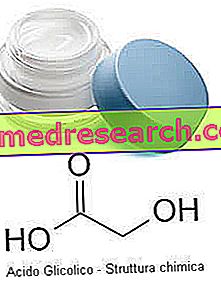Introduction
Among the cosmetics with exfoliating action, glycolic acid creams have undoubtedly aroused the interest (and enthusiasm) of the population, both female and male.

What is Glycolic Acid?
Glycolic acid - otherwise known as hydroxyacetic acid - is an alpha-hydroxy acid belonging to the group of well-known fruit acids, of which it is the smallest exponent from the point of view of chemical structure.
It is a molecule with exfoliating and lightening activities that are widely used in both the cosmetic and dermatological fields.
Did you know that ...
Glycolic acid - like most alpha-hydroxy acids - is derived from natural sources, particularly from fruit, sugar cane and sugar beet. However, glycolic acid is also produced by synthesis.
It is this natural origin - and, in particular, the origin of the fruit - that has given the name "fruit acids" to this group of chemicals.
Applications
Being a known depigmenting agent, glycolic acid is widely used for the creation of lightening creams, therefore it is an excellent remedy against skin blemishes (of the face, in particular).
But that's not all: glycolic acid - along with other fruit acids such as malic acid, tartaric acid, mandelic acid and citric acid - are widely used in cosmetics for their exfoliating properties. Not by chance, these molecules are the main ingredients for the preparation of chemical peels or scrubs, both in the cosmetic field and in the medical-dermatological field.
However, glycolic acid is a cosmetic ingredient widely used for the preparation of exfoliating creams thanks to its particular chemical structure which favors its absorption through the epidermis. In fact, being a small molecule (low molecular weight), glycolic acid is easily absorbed through the stratum corneum.
How it works
As mentioned, glycolic acid creams exfoliate and lighten. This activity, of course, is attributable to the action carried out by this alpha-hydroxy acid.
In fact, fruit acids and glycolic acid in particular are able to reduce the bonds and cohesive forces that hold together the corneocytes present on the superficial layers of the skin, acting - more precisely - at the level of desmosomes.
Thanks to this particular mechanism of action, therefore, the exfoliation of the superficial layers of the epidermis is obtained, which results in an increase in the speed of cellular turnover processes.
The increase in the rate of cell turnover, in turn, causes an increase in fibroblast activity, with a consequent increase in the synthesis of new collagen, new elastin and new glycosaminoglycans.
All these processes therefore lead to the attainment of the lightening, exfoliating and smoothing effect typically given by glycolic acid creams.
uses
Glycolic acid creams are indicated both in the dermo-cosmetic field and in aesthetic medicine. The discriminating factor that distinguishes glycolic acid creams for dermo-cosmetic use from those for medical use is the concentration of the same acid in the preparations in question. In fact, the creams used in cosmetics contain a concentration of glycolic acid that is decidedly lower than those used in the medical field.
Dermo-cosmetic use
In cosmetics and dermatology, glycolic acid creams are used to treat:
- Acne;
- Keratosis / hyperkeratosis;
- Seborrheic dermatitis;
- Acne scarring;
- Eye bags;
- Oily skins (glycolic acid creams normalize sebum production by the sebaceous glands);
- Prevent the onset of skin spots due to excessive exposure to UV rays (solar or artificial);
- Prevent the onset of age-related stains;
- Psoriasis;
- Dry skin.
For the treatment of acne, psoriasis, scarring of acne and keratosis, lightening / exfoliating creams are formulated with a concentration of glycolic acid ranging from 10 to 15%.
At concentrations below 10%, glycolic acid is generally used to prepare creams with a purely hydrated action, as it restores their natural softness and elasticity to dehydrated and dry skin. However, hyaluronic acid creams are generally more suitable for this purpose.
Use in aesthetic medicine
In aesthetic medicine, glycolic acid creams are often required to treat:
- Cloasma, melasma and freckles;
- Skin aging;
- Lentigo senili;
- Withered skin;
- Surface wrinkles;
- Stretch marks.
Professional glycolic acid creams must be administered by specialists or, in any case, require medical prescription before use. This is because, as mentioned, the concentrations of glycolic acid in creams used in aesthetic medicine are much higher than the previous ones. For example, some creams are prepared with glycolic acid at a concentration higher than 50% (sometimes up to 70-80%): from here it can be understood how some types of skin - especially those that are particularly sensitive - can react negatively to the product, producing even very unpleasant side effects (allergies, itching, irritation, etc.). In addition to this, such concentrated products generally need to be handled by specialized medical personnel who are experts in this field, so as to avoid complications and prevent the onset of final results that are counterproductive, unaesthetic, or worse, dangerous to health.
Other active ingredients
Normally, the formulation of exfoliating creams contains more cosmetic ingredients with similar activity. Glycolic acid, a lightening / exfoliating substance par excellence, is therefore associated with several substances in order to enhance its final effect.
In addition to glycolic acid, "anti-stain" creams can be prepared with one or more of these active ingredients:
- Kojic acid (or Kojic acid): supports the exfoliating action exerted (excellently) by glycolic acid.
- Lactic acid, another hydroxy acid: creams formulated with lactic acid and glycolic acid (eg Dermovital Clair) are particularly indicated for the treatment of solar / senile lentigo, pregnancy spots and for post-operative hyperpigmentation.
- Vitamin E, a powerful antioxidant.
- Retinoic acid (acid form of vitamin A): substance widely used in association with other depigmenting agents, including glycolic acid. The retinoic and glycolic acid based creams exert a marked exfoliating action aimed at softening the stratum corneum.
Mode of use
For cosmetic use, glycolic acid creams should be applied directly to skin washed with mild detergents and thoroughly dried.
It is suggested to apply the product with the fingertips, massaging gently to facilitate absorption. Given that each treatment is a case in itself, in general, glycolic acid creams must be applied once a day for a variable period of time (generally, until the desired result is achieved). Afterwards, continue applying the cream every other day.

This speech, of course, is valid only for glycolic acid creams intended for dermo-cosmetic use. As for the creams intended for use in aesthetic medicine, on the other hand, the applications cannot be daily due to the high concentration of glycolic acid contained in them. However, the doctor will provide all the necessary information on this.
In any case, it is strongly recommended to avoid sun exposure in the 24-48 hours following the professional treatment with lightening creams with glycolic acid.
Results
A regular and constant use of creams with glycolic acid (alternated or combined with emollient and nourishing creams) gives hydration and softness to the skin, which appears smooth, smooth, with a homogeneous and extremely luminous complexion.
In fact, glycolic acid creams - thanks to their ability to remove dead skin cells from the skin surface while promoting cell renewal - give the skin a brighter, more uniform and renewed appearance, as the skin is smoothed and moisturized at the same time.
However, appreciable improvements are visible only 10-15 days after starting treatment with glycolic acid cream.
Side effects
Glycolic acid - similarly to what happens with other lightening and exfoliating agents - can cause side effects when applied to the skin.
After applying a glycolic acid cream, the most common side effects that can occur usually consist of redness and irritation of the skin.
The ambulatory applications of creams (or other similar products) to glycolic acid can give rise to an unpleasant perception of burning, which still tends to fade after a few minutes or half an hour: the perceived tingling is subject to the concentration of active ingredient in the cream .
Furthermore, the possible onset of allergic reactions in individuals sensitive to glycolic acid should not be forgotten.
Precisely in this regard, moreover, it is generally advisable to prefer lightening and exfoliating cosmetic products (based on glycolic acid or not) without perfume: in fact, perfumes - acting as allergens - are the main responsible for skin reactions.



